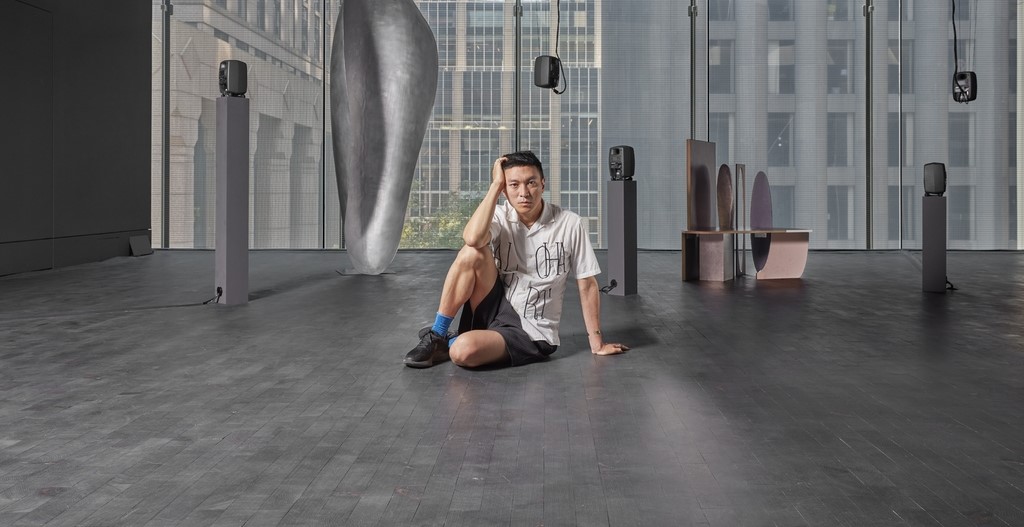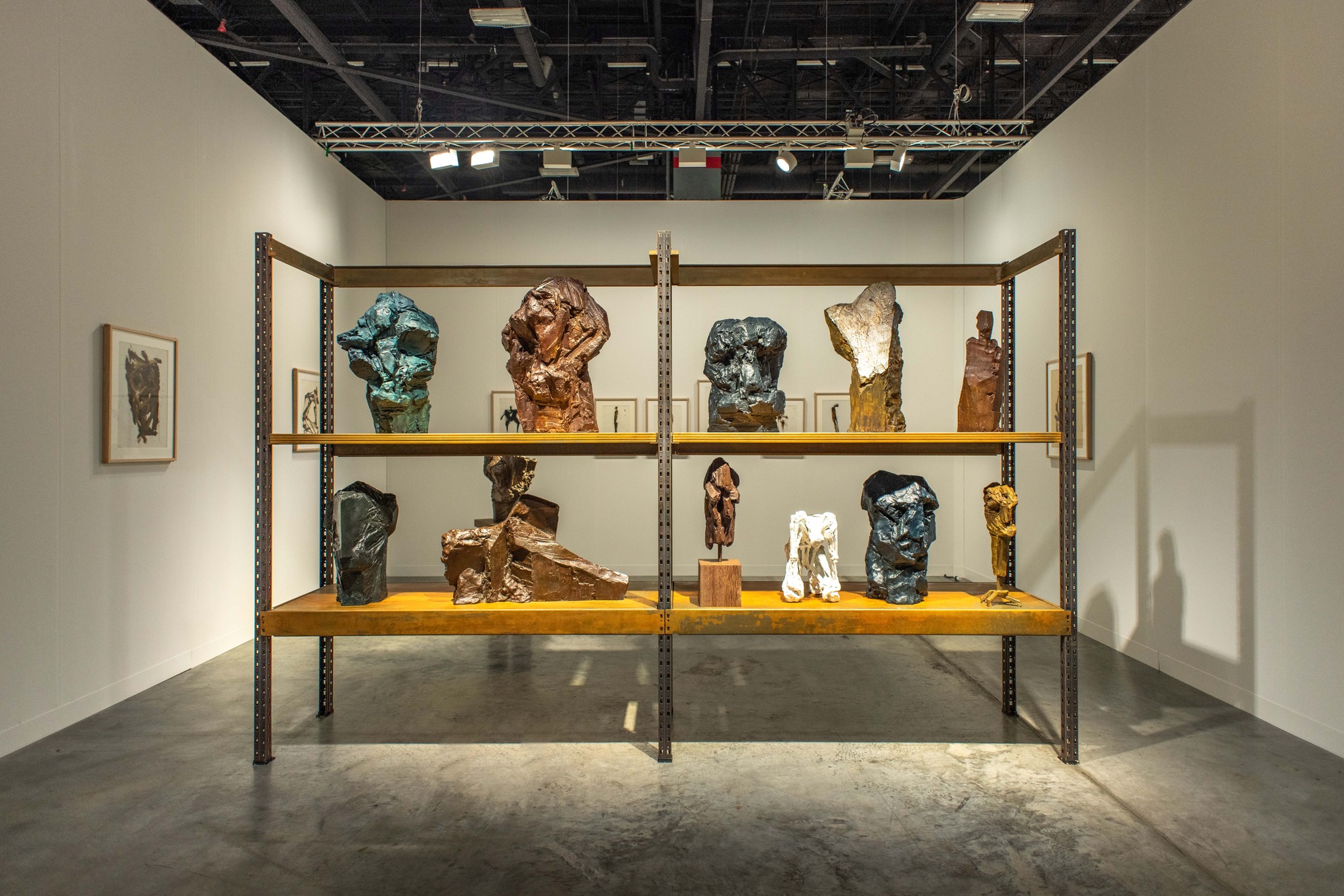Sung Hwan Kim (b. 1975), who works between
New York and Amsterdam, has showcased a diverse range of works, incorporating
various media such as film, video, drawing, music, architecture, and literature
into installations, performances, radio dramas, and books. By utilizing these
complex media, Kim develops a unique form of visual storytelling, gaining
significant recognition both domestically and internationally.
Kim focuses on the space, history,
language, and culture of a specific era referred to as the ‘present,’ exploring
how social systems and educational institutions relate to the way we think and
receive information. His works, often incorporating elements of biography,
science fiction, folklore, mythology, and collective memory, create metaphors
that address historical and social issues.

Installation view of “A-DA-DADA” (Total Museum of Art, 2003) ©Sung Hwan Kim. Photo: David Michael DiGregorio
In 2003, after studying
mathematics, architecture, and fine arts in the U.S., Sung Hwan Kim held his
first exhibition in Korea titled “A-DA-DADA” at Total Museum of Art. In this
show, he presented his works A-DA-DA (2002) and her
(2003) alongside pieces by his mentor, video artist Joan Jonas, experimental
filmmaker Joe Gibbons, and his friend Nina Yeun.
By showcasing video art across
different generations, Kim also prepared works from over 40 video artists and
filmmakers who had influenced his own practice as reference material. Though
the exhibition focused on Kim, it wove together a network of many interconnected
works, creating a rich, layered experience.

Sung Hwan Kim, A-DA-DA, 2002 ©Sung Hwan Kim
The
artist explained this exhibition approach by stating, "A single person's
brain is merely one of the countless objects in the world. Therefore, an artist
holding a solo exhibition should consider whether to display only their own
work or to recognize that their creations are also social products and present
their surrounding world along with their own works."
In
this exhibition, Kim used the onomatopoeic phrase "A-DA-DADA," which
represents stuttering, as the theme, showcasing the process of shaping his
unique visual language through verbal refinement. For instance, in the video
work A-DA-DA (2002), he had two Asian Americans perform as a
Korean father and son, using stuttering and faltering communication to explore
the culturally and generationally disconnected relationships.

Sung Hwan Kim, Washing Brain and Corn, 2010 ©Sung Hwan Kim
In
this way, Sung Hwan Kim’s video works prioritize narrative, historicity, and
performativity over the visual effects or installation aesthetics typically
associated with video art. His video piece Washing Brain and Corn
(2010), commissioned for the Media City Seoul in 2010, combines events from
Korea’s modern history with fictional tales, autobiographical elements, and
collective memory.
The
work began with Kim imagining the image of a hand washing a brain with water—a
reference drawn from Rilke’s poem Corpse-Washing, where the
act of washing a corpse is described, evoking associations with washing brain.
The video is based on the story of Lee Seung-bok, a boy killed for reportedly
saying, "나는 공산당이 싫어요(I hate communists)," which was used extensively in
anti-communist ideology education in Korea. Kim narrates this story through the
voice of his young second-generation Korean American niece.
Unfamiliar
with the historical context, the child tells the story in English but switches
to Korean to say the phrase "나는 공산당이 싫어요." This work raises questions about how
history is translated through others in contexts of temporal, geographical,
cultural, and linguistic disconnections.

Installation view of “Sung Hwan Kim” (The Tanks at Tate Modern, 2012) ©Sung Hwan Kim
Washing Brain and Corn later expanded into a radio play and publication, and was last shown in its full installation version for the Tanks at Tate Modern in 2012, when Kim was the first commissioned exhibition artist in that new space.

Sung Hwan Kim, Temper Clay, 2012 ©Sung Hwan Kim
In this way, Sung Hwan Kim has consistently
borrowed from literary texts to create works that metaphorically explore
relationships between individuals, history, and humanity. His 2012 video work
Temper Clay is a reinterpretation of Shakespeare’s tragedy
King Lear, centered around modern Korean history.
The title, ‘Temper Clay,’ refers to the act
of mixing clay with water and is taken from a line in King
Lear. "Old fond eyes, Beweep this cause again I’ll pluck ye out
And cast you, with the waters that you loose, To temper clay." Kim uses
this imagery to draw parallels between the familial conflict and disintegration
seen in King Lear, driven by desires for power and wealth,
and the conflicts, absurdities, and tragedies of Korean society.
The setting of the work—a lakeside villa
and a 1970s apartment complex in Apgujeong-dong—functions as a mirrored
structure that reflects both the time and space of King Lear
and post-1970s Korean society, intertwining their historical and social
contexts.
 Installation
view of “Sung Hwan Kim: Life of Always a Mirror” (Art Sonje Center, 2014) ©Art
Sonje Center
Installation
view of “Sung Hwan Kim: Life of Always a Mirror” (Art Sonje Center, 2014) ©Art
Sonje CenterIn his 2014 solo exhibition “Life of Always a Mirror” at Art Sonje Center, Kim presented an experimental exhibition that organically combined videos, drawings, installations, and performances, including Temper Clay. Through this integrated approach, Kim explored the exhibition as an educational method, offering a reflective and innovative structure that invited viewers to reconsider the role of exhibitions.
 Installation
view of “Sung Hwan Kim: Life of Always a Mirror” (Art Sonje Center, 2014) ©Art Sonje
Center
Installation
view of “Sung Hwan Kim: Life of Always a Mirror” (Art Sonje Center, 2014) ©Art Sonje
CenterFirst of
all, the artist transformed the architectural structure of the exhibition as a framework
to rethink the attitudes and methods of teaching that are prevalent in society.
He divided the exhibition into two distinct spaces based on their character and
composition, creating a mirror-like structure that repeatedly reflected the
existing architecture. The entrance was moved beyond a long corridor, and different
heights architectural installations appeared in a proliferating, repetitive
manner, creating a maze-like path.
This
exhibition extended Kim's ongoing exploration of displacement in time and space
into the spatial dimension. The space, in turn, resonated with works that
shared these themes, allowing viewers to experience the ripple effects,
transformations, or fading of narratives across different eras and spaces in a
more immersive, multisensory way.

Sung Hwan Kim, Love before Bond, 2017 ©Sung Hwan Kim
Meanwhile, in his work Love
before Bond (2017), which was produced for the main exhibition of the
Venice Biennale, Sung Hwan Kim raised questions about the ethics and aesthetics
of race, culture, and migration. The piece freely incorporates and connects
texts from various sources, such as Korean news articles and Shakespeare’s Sonnets,
using language as a medium not just for directive function but as something
devoid of inherent authorship, with endless potential for transformation.
The video references historical events
with social significance, such as the 1992 LA Riots, which involved clashes
between African Americans and Korean immigrants. In the video, a
Korean-American girl and a Sudanese boy mirror each other’s learned gestures
for avoiding discrimination, metaphorically addressing the issue of racial
discrimination in American society.
 Sung
Hwan Kim, Hair
is a piece of head, 2021
©Sung Hwan Kim
Sung
Hwan Kim, Hair
is a piece of head, 2021
©Sung Hwan KimKim’s recent work Hair is a
piece of head (2021), shown at the Hawai'i Triennial 2022, delves
into the history of immigrants from early 20th century Korea to the United
States. It forms part of his ongoing multi-research series, A Record
of Drifting Across the Sea (2017–), and is presented through video,
books, and installation.
Hair is a piece of head
is set in Hawai'i, which served as both a geographical and conceptual transit
point not only for Korean immigrants but for many early immigrants crossing the
Pacific for centuries. Hawai'i was often the first "American land"
they stepped onto. By interpreting Hawai'i as both a geographical location and
an idea, Kim connects the figure of the drifter to the land where they landed,
using this as a method to understand the tragedy of a foreign country.
He explores what is uncovered during
the process of historicizing this journey and what new structures and images
emerge from it. Through the juxtaposition of metaphorical scenes and archival
photographs, new cognitive and psychological boundaries are established.
 Sung
Hwan Kim, Hair
is a piece of head, 2021,
Installation view at Hawaiʻi Triennial 2022 (Honolulu
Museum of Art, 2022) ©Sung Hwan Kim. Photo: Suin Kwon
Sung
Hwan Kim, Hair
is a piece of head, 2021,
Installation view at Hawaiʻi Triennial 2022 (Honolulu
Museum of Art, 2022) ©Sung Hwan Kim. Photo: Suin KwonIn this way, Kim unravels the diverse and complex layers embedded in history and the way they are transmitted through his own poetic lens. By borrowing from literary texts and journalistic records, he reconstructs these into new forms of storytelling, shaping them into multi-layered visual structures across various media. In doing so, he creates a narrative web that infiltrates the psychological and cognitive dimensions of the audience, generating possibilities for alternative communication.
"Before
I use language, there exists the history and transformation of that language by
those who used it before me. When I attempt to convey something through such a
language, I see the history of how that content has been delivered.
And
as I think about the will and the intention behind communicating that content,
I also consider how it has been recorded. When communication occurs, I think
about the personal history of the people involved, the economic and cultural
background that shaped them, and the history of the place where the
communication takes place. I create the records of communication through my
work while reflecting on these factors."
(Sung
Hwan Kim | Leeum Meets the Artists #41)

Artist Sung Hwan Kim ©Barakat Contemproary
Sung Hwan Kim studied architecture at
Seoul National University before moving to the United States, where he double
majored in mathematics and art at Williams College. He later earned a master's
degree in visual arts from MIT and completed a residency at the Rijksakademie
Amsterdam. Kim is the winner of the Hermès Korea art prize (2007), the Prix de
Rome (2007), and, with dogr, the Karl-Sczuka-Förderpreis (2010) for the radio
work one from in the room.
He has held solo exhibitions at
various venues including Museum of Modern Art (New York, 2021), daadgalerie
(Berlin, 2018), The Tanks at Tate Modern (London, 2012), Kunsthalle Basel (Basel,
2011). He has participated in group exhibitions including the Hawaiʻi
Triennial 2022 and 57th Venice Biennale (2017).
References
- 김성환, Sung Hwan Kim (Artist Website)
- 2022 부산비엔날레, 김성환 (2022 Busan Biennale, Sung Hwan Kim)
- 바라캇 컨템포러리, 김성환: 밤의 기스 (Barakat Contemporary, Sung Hwan Kim: Night Crazing)
- 연합뉴스, 비엔날레 출품작들을 만나다…김성환 바라캇 컨템포러리 개인전, 2022.08.30
- 국립현대미술관, 김성환(데이비드 마이클 디그레고리오(dogr로도 알려진)와 음악 공동 작업) | 템퍼 클레이 | 2012 (National Museum of Modern and Contemporary Art Korea (MMCA), Sung Hwan Kim(in musical collaboration with David Michael DiGregorio a.k.a. dogr) | Temper Clay | 2012)
- 아트선재센터, 김성환: 늘 거울 생활 (Art Sonje Center, Sung Hwan Kim: Life of Always a Mirror)


















